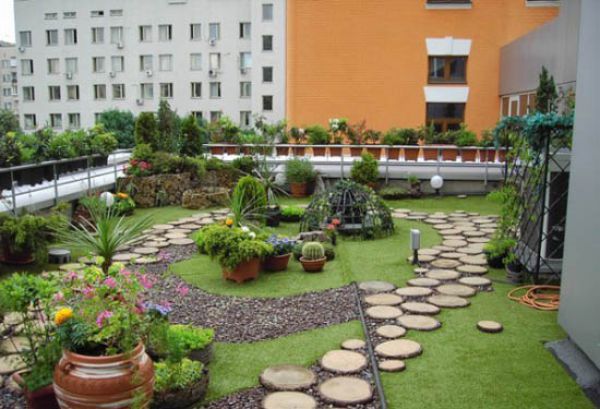It is known that one of the most significant tools in the combat against global warming which became more and more an important environmental problem is preserving the green areas. In cities rapidly overbuilding where this opportunity gets increasingly difficult to achieve, addition of structural sections such as roofs, terraces above garages as greenery fields in addition to the parks and gardens gets significance not only for aesthetical appearance but also for environmental awareness. The green areas that had to remain within the cities have left their places to concrete structures due to the constant pressure of residential and commercial urbanisation. Air pollution became the fundamental problem of many cities. Constantly increasing high structures prevented air circulation, leading to pollution and warming. As water consumption increased in cities and industrial areas, decreased surface area of soil to absorb the rain due to concrete structuring caused the wastewater systems of cities get more and more overloaded. Due to the now inadequate infrastructures, many cities have to deal with frequent floods. One of the most effective solutions to this situation is to recover the lost green areas by recreating them on the structures, meaning greening the roofs. Such applications are applied as a mandatory zoning rule in some developed countries such as Germany. Green roof system is recommended as a perfect solution in greening flat or sloped roofs.
Intensive (dense), extensive (loose) green roofs: The two main methods in creating roof gardens are intensive (dense), extensive (loose) greening. In intensive greening system, abundant soil amounts are used; it can even be possible to grow shorter trees on the roof. The load that intensive system burdens on the roof is generally around 300 kg/m2. This system may only be utilised in structures designed previously for this purpose. Also, intensive roof gardens should be held under constant maintenance. With extensive greening, light roof gardens may be created. With the special materials and methods utilised, the load on the roof is under 100 kg/m2. In other words, in case a flat roof covered with aggregate, concrete or tiles or a sloped roof covered with roof tiles are greened by removing these materials, the load on the structure does not increase. Furthermore, roofs greened via extensive method require maintenance at most once or twice per year. In ondugreen system, extensive greening methods are utilised.
WHY GREEN ROOF ?
Wastewater amount decreases
Depending on the characteristics of the system chosen for green roof design, the amount of water to be drained off the roof can be decreased up to 90%. Therefore, the wastewater pipes utilised within he structure or the city grid are less overloaded. More units may be provided service with the same size pipes, or by using lesser pipes material saving may be achieved.
Environmental climate properties change
Respiration properties of plants cause the oxygen amount to increase. With the greening of roofs at within urban sections with dense construction and traffic activity, air cleaning may be achieved. Habitable environments with more precipitation and cooler summers are created.
Less dusty environments are created
Green roofs aid in filtering the dust particles suspended in the atmosphere. Nitrate and some similar hazardous substances that exist in the air or rainwater are absorbed and conveyed into the soil.
Roof heat insulation increases
Green roofs provide insulation against the heat. With some green roof types supported with polystyrene foam, obtaining roof heat insulation capacity increases up to 50% may be possible.
And better heat insulation means saving from heating and cooling energies.
Ambient noise decreases
The magnitude of noise reflected by surfaces covered with greenery are lower by 3 dB than other roof surfaces. Furthermore, the noise entering the structure from the roof may be decreased by 8 dB. This property provides an important advantage for structures near noisy regions such as airports and highways.
Longer life is provided to the water insulation
Green roof system prevents the freezing colds of winter affecting the building, and prevents the structure crust to be heated in the summer. Therefore, water insulation materials are protected better against the excess heat differences, harmful ultraviolet light and mechanical impacts, permitting them to function longer.
New areas of use are obtained
Instead of aggregate covered terrace roofs, habitable exterior environments combined with planted areas can be obtained. For locations such as centrums that bear little or no natural environments, roofs are the only structural section that may function as a garden.
Natural environment means beauty
Lack of natural environments clearly felt in our current day cities where common green areas are inadequate may be significantly eliminated by greening the roofs. The most positive contribution that may be provided to the existing urban fabrics is to bring the beauties of nature to the urban structures’ roofs that are mostly devoid of aesthetics.
MAIN LAYERS
- In case the plants are applied within a system framework, there are plant species -obtained through experiments conducted by expert research institutes- that can live without deteriorating for years and provide special characteristics to the structures in accordance with the region’s climate properties, and these are used for greening the roofs.
- Plant bearer layer: The infra structures constituted with special materials such as system soils meets all nutrition requirements of the selected plant, ensuring the plants to remain alive and beautiful for years by facilitating their self renewal.
- Filtering and drainage layer: Rainwater coming from upper layers filtered by a filtering layer should be stored for rainless days but should be drained and discharged if accumulation exceeds a certain level to prevent rotting of the plants.
- Layer for protection against mechanic effects: Special felts resistant to rotting protect root holding layers and water insulation layers against mechanical effects. Protective layers have the pressure resistance required by norms and quality certificates granted by authorised institutions.
- Root holding layer: Plant roots harming water insulation layers should be definitely prevented. For this purpose, either special root holder layers or water insulations capable of protecting itself against roots are utilised.
- Water insulation and roof construction: Existence of good water insulation and a roof construction of adequate bearing strength are the most important prerequisites of roof greening. In this case, insulation may be achieved especially with Geomembrane class membranes followed by membranes with high SBS content.

